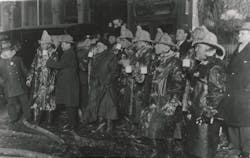KELLIHER, MN: FEB. 4, 1914 – A wave of intense cold fell upon the entire region, dropping the temperature to 17 degrees below zero. Due to the extreme cold, the furnace in the three-story frame hotel in town was working overtime. The overheating of the system caused a fire that swept the structure and left at least five men dead and several missing. Thirteen other people were injured by the blaze.
ROUBAIX, FRANCE: FEB. 7, 1914 – At 3 A.M., the firemen from this small French border town received a request for mutual aid from the Belgian village of Hersaux. A serious fire was threatening to wipe out the entire frontier village. As the French motorized fire brigade reached the bridge that crosses over the tiny stream separating the two nations, a French customs official told the fire brigade officer, “You can go if you like, but when you come back you cannot bring your motor car with you. The customs regulations forbid that.” Undaunted, the firemen placed their pumper inches inside the French boarder and stretched hose all the way to the fire. It is not known if the hose was confiscated later by customs.
NEWPORT, RI: FEB. 9, 1914 – Quick-thinking members of a U.S. Navy submarine crew saved their vessel from fire. While taking a break in the galley, the crew was engulfed in a cloud of heavy smoke. One sailor turned in the alarm as the others went to investigate to cause. A blaze was found burning among a pile of oily rags. Members advanced a powerful hose and extinguished the fire. The submarine was G-1, a lake-type submarine, and it suffered little damage.
NEW YORK CITY: FEB. 11, 1914 – Flames broke out on the second floor of a six-story loft building on 34th Street in Manhattan. By the time firemen arrived, the flames had spread to the floor above and were racing up the stairs toward the roof. Companies attempting to ventilate the roof were driven to the adjacent roofs. As hoselines were positioned to stop the fire from spreading to the adjoining buildings, the fire apparently reached stored paints and oils on the top floor. The thick, black smoke became a pumping and swirling toxic cloud. Firemen were hard pressed to breathe the chocking fumes as they set up water towers, hoping to knock down the raging fire. Several times, the flames reached new supplies of oil and flames exploded through the roof. Four alarms were transmitted, streetcars and elevated subways came to a halt and seven firemen were dragged away, rendered unconscious by the dense smoke.
BERLIN, GERMANY: FEB. 13, 1914 – The Berlin Fire Brigade put on a demonstration and drill for Kaiser Wilhelm II and his guests at the castle. New aerial ladders, which could be extended to a height of 85 feet instantaneously by power generated from carbonic acid, attracted the most attention. Several old-fashioned ladders, raised by reel, were also extended to show the difference. A water mast was demonstrated, throwing a powerful stream from its lofty position. A dramatic display featured a fireman, clad in diver-like fireproof clothing, walking through a blazing pile of petroleum-soaked wood. The kaiser was delighted with the display.
ASHLAND, ME: FEB. 21, 1914 – While the father was away at work, the mother and six children were asleep in their two-story house. The mother woke to find the home on fire and five of her children trapped in the upstairs bedrooms. After several attempts to climb the stairs to reach the children, she and a daughter were forced from the blazing house. Faced with sub-zero temperatures and wearing only her bedclothes, the mother continued trying to save her children. As her daughter ran for help, the mother climbed on top of a shed adjoining the house and, with her bare hands, battered in the glass windows of the room where her children slept. Her efforts were in vain. Neighbors later found her, unconscious and near death, suffering from exposure and serious lacerations from the broken glass. Sadly, the flames killed the five children.
OLEAN, NY: FEB. 22, 1914 – A fire that began at 3 A.M. in the Miller Hardware Co. spread to the adjoining stores and threatened the entire business area of the city. Firemen were hard pressed to slow the advancing flames. Guests in the Olean House hotel, directly across the street from the fire, were roused from their beds and dressed quickly, waiting in the lobby ready to flee if the fire ignited the hotel. The flames, however, were stopped before they could jump the street.
MORRISTOWN, NJ: FEB. 23, 1914 – A fire that began in the basement of the Morristown Free Library spread up through partitions within the granite structure. When firemen reached the scene, the flames had already reached the second floor. The fire department shifted its efforts to keep the extending fire from reaching adjoining properties. Lost in the flames were many valuable historic documents and records and more than 50,000 books.
PAUL HASHAGEN, a Firehouse® contributing editor, is a retired FDNY firefighter who was assigned to Rescue 1 in Manhattan. He is also an ex-chief of the Freeport, NY Fire Department. Hashagen is the author of FDNY: The Bravest, An Illustrated History 1865-2002, the official history of the New York City Fire Department, and other fire service books. His novels are available at dmcfirebooks.com. Hashagen is also a member of the Author’s Guild. Visit paulhashagen.com or Paul Hashagen-author on Facebook.
Paul Hashagen
PAUL HASHAGEN, a Firehouse® contributing editor, is a retired FDNY firefighter who was assigned to Rescue 1 in Manhattan. He is also an ex-chief of the Freeport, NY, Fire Department. Hashagen is the author of FDNY: The Bravest, An Illustrated History 1865-2002, the official history of the New York City Fire Department, and other fire service books.
Connect with Paul
Website: paulhashagen.com
Facebook: Paul Hashagen-author






